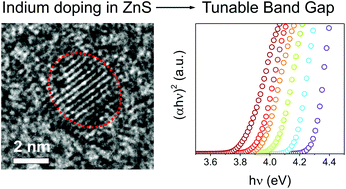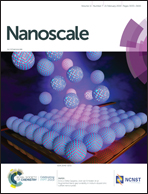Augmented band gap tunability in indium-doped zinc sulfide nanocrystals†
Abstract
Doping semiconductor nanocrystals is a powerful tool to impart new and beneficial optical and electrical properties to the host nanocrystals. Doping has been used to improve the performances of nanocrystal-based devices in applications as diverse as optics, magnetism, electronics, catalysis and sensing. In this work we present a low temperature colloidal synthesis of zinc sulfide (ZnS) nanocrystals doped with indium. Through optimization of the reaction parameters and the doping level, quantum confined (∼2 nm in size) crystalline colloids with highly tunable optical properties are achieved. Using a suite of characterization techniques including X-ray diffraction, high-resolution transmission electron microscopy, optical spectroscopies (absorption, emission, and Raman), compositional analyses and first principles simulations, we investigate the structural, morphological and optical properties of the synthesized nanocrystals. Indium dopants are found to heavily influence the band gap of ZnS. This strategy in addition to traditional methods of size control enables the synthesis of nanocrystals with finely tunable band gaps between ∼3.8 eV–4.3 eV. These doped ZnS nanocrystals are fabricated into selective UV thin-film absorbers and discriminatory proof-of-concept UVA–UVB/C photodetectors.



 Please wait while we load your content...
Please wait while we load your content...